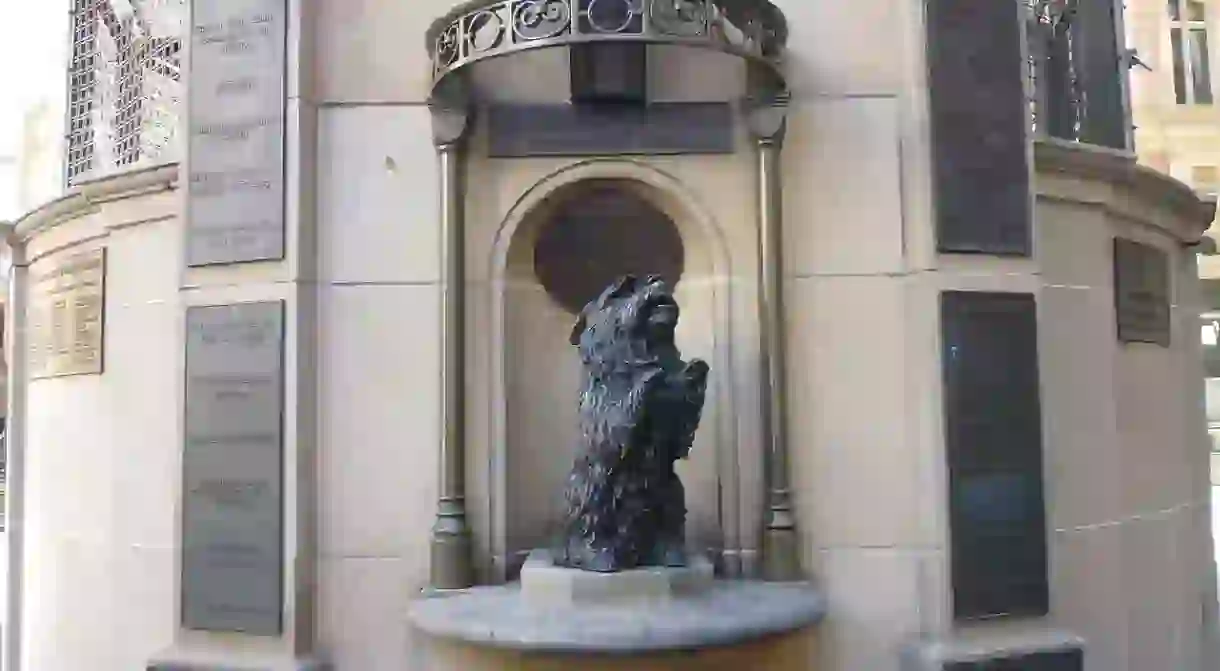Meet Sydney's Talking Dog

Have you ever heard a canine speak? Well if you’ve visited Sydney’s Queen Victoria Building, you probably have.
You can’t miss the enormous statue of Queen Vic looming over George Street outside the iconic QVB, but it’s easy to overlook her diminutive canine companion. And although this two-foot-tall terrier might be one of Sydney’s smallest statues, it’s also one of the Harbour City’s most talented. Introduce yourself to Islay the talking dog and learn why it was given the gift of the gab.
Queen Victoria Building
Islay lives outside the Queen Victoria Building, one of Sydney’s most recognisable colonial-era landmarks located on George Street in the heart of the city. Named after Queen Victoria to celebrate her Diamond Jubilee in 1897, this domed Romanesque Revival masterpiece is one of Australia’s many grand retail buildings from the Federation era, alongside South Australia’s Adelaide Arcade and the Block and Royal Arcades in Melbourne.

The QVB fell into disrepair and was even going to be demolished and turned into a car park before a Malaysian company restored the building to its former glory in the 1980s. As part of the facelift, a statue of Queen Vic herself — abandoned in a field in Ireland, after being removed from outside parliament decades earlier — was added to the exterior. The irony of a British monarch being ‘transported’ Down Under from Irish shores wasn’t lost on the Australian public.
Islay the talking dog
The redevelopment of the QVB produced an unsightly ventilation shaft that was cleverly covered by a sandstone wishing well. The decoration? Queen Victoria’s favourite pet, a skye terrier by the name of Islay.

The real Islay was Queen Victoria’s companion for five years until it sadly met a premature end at the claws of a rogue feline — it died in 1844 and is buried at Windsor Castle. Islay made quite the impression on the Grandmother of Europe over its short life. “I am charmed with my new little dog, whom I have called Islay. He is so gentle, so good natured and friendly and so funny, for he begs delightfully,” the Queen wrote in her diary in 1839.

Queen Victoria was particularly fond of Islay’s adorable habit of standing on its hind legs to beg for a treat — the very pose it is cast in bronze performing outside the QVB. The 60 cm statue was sculpted by local artist Justin Robson in 1987, who based the piece on an 1843 sketch by the Queen.
Why does it speak?
The QVB’s wishing well raises money for the Royal Institute for Deaf and Blind Children in Sydney and Islay did such an effective job being the mascot of the cause that it was given a voice in 1998. It even convinced Queen Elizabeth II to part with a coin during her 1988 visit.
The little pup runs through its speech every 40 seconds around the clock: “Hello, my name is Islay. I was once the companion of the great Queen Victoria. Because of the many good deeds I have done for deaf and blind children, I have been given the power of speech. If you cast a coin into the wishing well now, I will say thank you… Thank you. Woof, woof.”
Islay’s dulcet voice is that of Sydney radio shock jock John Laws, who even supplied the bark at the end. Laws was embroiled in a ‘cash for comment’ scandal soon after lending his tonsils to the spiel, so Sydneysiders were accustomed to hearing him yap for a dollar.
Islay’s wishing well also features a poem explaining its story in English and in Braille, four proverbs translated into six different languages and even a stone from Blarney Castle, the Irish fortress that fittingly gives the gift of the gab to those who kiss it.













